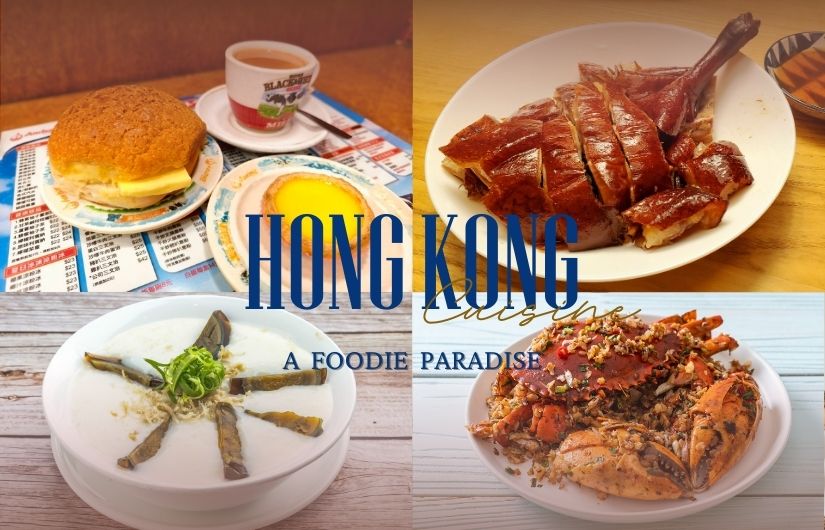Hong Kong: A foodie paradise
By Kathleen Pokrud
Over the years, Hong Kong, a Special Administrative Region of China, has cultivated a distinctive culinary landscape blending Chinese and international flavors. As an international cosmopolitan city and global financial hub, Hong Kong has long been a magnet for visitors from around the world, drawn by its dynamic business environment and vibrant tourism scene. Food is one aspects, among others, which leaves lasting and fond memories for visitors. I sat down with Mr Parson Lam, Director of the Hong Kong Economic and Trade Office in Bangkok to learn about the rich culinary heritage of Hong Kong.
Director Lam began, “Hong Kong is an international metropolis where East meets West. We have a unique culinary scene unlike any other. On one hand, Cantonese cuisine, renowned for its emphasis on fresh ingredients, delicate flavours and meticulous cooking techniques, has left an indelible mark on Hong Kong’s culinary landscape. On the other hand, over the decades, as an international business hub, Hong Kong has attracted a diverse array of immigrants and expatriates from all corners of the globe. Their cultural contributions have enriched and diversified our culinary scene, imbuing it with a global flair that sets it apart from any other. This blending of traditional Cantonese flavors with international inspiration, creates a truly unique and diverse culinary experience for Hong Kong.
He proudly went on, “Hong Kong is regarded as a gourmet paradise. With around 15,000 restaurants, Hong Kong's culinary landscape features a diverse range of dining options, from world-class Michelin-starred tasting menus and fine dining to humble street food stalls. Hong Kong restaurants have been featured prominently in global rankings such as the Michelin Guide, Asia's 50 Best Restaurants and various food and travel publications. The 2024 edition of the Michelin Guide highlights 79 starred restaurants in Hong Kong. On the Bib Gourmand list presenting eateries at wallet-friendly prices, 67 establishments in Hong Kong were honoured. Furthermore, five Hong Kong restaurants have made it onto Asia's 50 Best Restaurants 2023 while eight more secured a place amongst the top 51–100.”
Seafood forms an integral part of Hong Kong gastronomy. Seafood markets in Hong Kong are no-frills affairs where the fresh catches are displayed in front of a stall or shop. Famous places to savour seafood are Sai Kung, Lei Yue Mun, Tai O and Temple Street.
The vibrant street food culture, with bustling markets and food stalls offer a wide array of affordable and delicious delicacies. From egg waffles to steamed dumplings and curry fish balls, Hong Kong's street food scene is a testament to its diverse culinary heritage. Going to ‘cha chaan teng’ (teahouses), ‘yum cha’ (dim sum), or eating in ‘dai pai dong’ (food stalls) are quintessential Hong Kong food experiences.”
As our interview drew to a close, Director Lam dwelt on a unique dining experience in Hong Kong, ‘Cha chaan teng’. “These tea restaurants are the epitome of Hong Kong’s East-meets-West culture. The famous Hong Kong-style milk tea with creamy and flaky egg tarts or buttery pineapple buns are just some of the unique Chinese and Western fusion comfort foods that can be found at these local cafes and diners.”
He reiterated, “In sum, Hong Kong gourmet is a fusion of Chinese and international flavors, as well as tradition with innovation. From traditional dishes like dim sum, roast meats, wonton noodles and clay pot rice, to innovative local creations featuring Western elements such as pineapple buns and Swiss rolls, etc., each dish tells the story of Hong Kong. Meanwhile, Hong Kong's rich street food culture still thrives, offering snacks like egg waffles, fish balls and stinky tofu. I welcome foodies to explore everything from street food stalls to upscale restaurants, serving a wide range of delicacies, reflecting the city's rich culinary heritage.”
Key representative dishes
Dim Sum
Hong Kong has perfected the art of making dim sum over generations, offering some of the finest and most authentic dim sum experiences in the world; with constant innovation and creativity by local chefs. A traditional Cantonese style of dining, consisting of small, bite-sized portions of food, served in bamboo steamers or on small dishes, often enjoyed with tea, Dim Sum is a staple of Hong Kong's culinary landscape. Classic dishes include Har Gow, Siu Mai, Rice Noodle Rolls and Barbecued Pork Buns.
Prawn wonton noodles
A classic local noodle dish, served as a quick meal, tender shrimp wontons and light egg noodles in an aromatic clear stock is the ultimate combo. Its affordability, delicious flavours and satisfying warmth make it a favourite comfort food for people from all walks of life.
Roast Goose
One of the defining features of Hong Kong roast goose is its crispy, golden-brown skin. Roast goose holds a special place in Cantonese cuisine and culture, symbolizing prosperity, abundance and celebration.

Typhoon Shelter Crab
The intensely flavoured Typhoon Shelter Crab is an iconic local Hong Kong dish. It originated from boat dwellers who lived in Causeway Bay. They brought in fresh crabs from the harbour and set up shop in typhoon shelters, frying up these mud crabs with loads of garlic and spices.
Hong Kong-style congee
Thais love smooth and creamy Hong Kong-style congee, made from rice cooked to a porridge-like consistency. It can be customized with various toppings and accompaniments according to personal preference.

Hong Kong-style milk tea
The outcome of a century-old evolution from English milk tea to the present popular beverage known as "silk stocking milk tea", it is made from Ceylon black tea and evaporated or condensed milk. Its unique tea-making technique: blending tea leaves, boiling and infusing before force-pouring the tea, then letting it brewing before force-pouring the milk, is listed as an Intangible Cultural Heritage of Hong Kong.
Hong Kong-style Egg Tarts
These are circular tarts of flaky pastry, filled with a smooth, lightly sweetened egg custard. They originated during the 1940s as a revamped take on the British custard tarts by Chinese bakeries and now sit high on the list of Hong Kong pastry greats.
Pineapple bun
A popular local snack with no pineapple at all, the name actually comes from their crusty domed appearance that resembles a pineapple. That flaky, crunchy, sweet crust atop the soft and fluffy bun is best experienced hot from the oven, complete with a thick, cold pat of butter that quickly melts. Best with a cup of strong Hong Kong milk tea.














































































































































































































































































































































































































































































































































































































































































































































































































